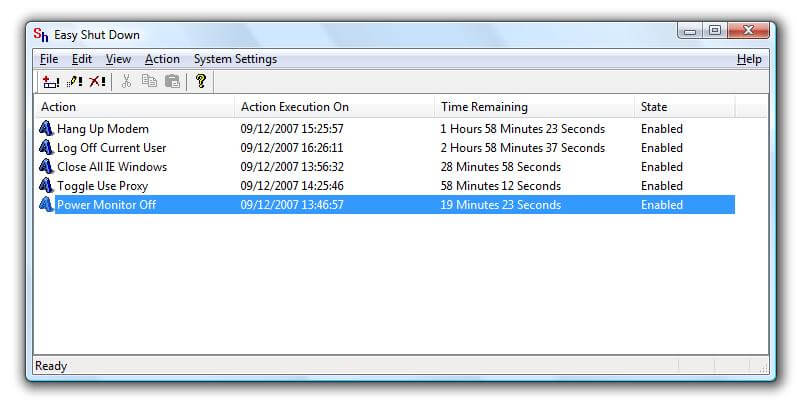- Screen Shutdown Timer Windows 10
- Pc Auto Shutdown Timer Windows 7
- Windows 7 Auto Shutdown Timer Software
Some of us like our PC to always be ready when we enter the room. Waiting for the system to boot up can be annoying. Thankfully, there is a solution that allows you to schedule startups and shutdowns to save you time, and possibly reduce your electricity bill.
Startup on schedule
This step will vary depending on what sort of BIOS your motherboard is running. You may not have the option to power on at a specific time, although most motherboards do indeed have this option. For anyone not familiar with the term – BIOS stands for “basic input/output system” and is basically where you setup the low-level confirguration of your motherboard. It is distinct to any Operating System you may be using. Please note that the second portion of this guide regarding automatically shutting down your system is written for WIndows 7, but may also be applicable to other versions of Windows.
Just open Run Command Window by pressing ‘Windows key+r’ and type ‘shutdown -s -t 3600’ and press ‘Enter’. Here ‘3600’ is the time in ‘seconds’. A message will pop up that Windows will automatic shutdown after the set specific time.
- Autoplay When autoplay is enabled, a suggested video will automatically play next. Up next Automatic Shutdown on Windows 7 (No programs or installs required) - Duration: 6:19.
- Ways To Schedule Automatic Shutdown Timer On Windows 10 & 7. So, here is the list of methods to set up an auto shutdown timer on Windows 10 and Windows 7. Method 1: Set Up an Auto Shutdown Timer via Run. Step 1: Go to Start Menu and type ‘Run’ or press ‘Windows + R’. Step 2: In Run, type ‘shutdown –s –t number’.
Step 1. Restart your computer.
Step 2. If you have a recent PC you are probably greeted with a cheesy promo screen for whatever brand motherboard is in your system. It will likely say something like “Press DEL to enter BIOS”. If you have an older system, you will see the RAM check and hard drive detection taking place. Either way, you should tap the DEL key within the first 1-3 seconds of restarting. After a few seconds, you should find yourself in the BIOS. If windows begins to start again, you’ve done something wrong and need to restart once more. If you are using a notebook computer, then you may need to Google your model to figure out what key to press to enter the BIOS.
Step 3. Depending on which brand motherboard you have, the BIOS will look different. You need to find the menu entitled Power, or Power Management. Within this should be an option labeled “Resume on RTC Alarm” or “Power on By RTC Alarm”. You should Enable this option, then set the time and frequency (e.g. “Everyday”) that you would like the system to turn on.
Step 4. Ensure that you select the “Save and Quit” option when leaving the BIOS setup. Do not just press the reset button on your computer, otherwise your settings will not be saved. From this point on, your system should start up at the time and frequency you set in the BIOS. If it does not, it’s best to consult your motherboard manual for more information.
Shutdown on Schedule
Step 1. Click the Windows button and type in “task”, the Task Scheduler application should show up in the list. Run it.
Step 2. In the right-hand panel, click on “Create Basic Task”
Step 3. Enter an appropriate name and description (e.g. Scheduled system shutdown), click Next.
Step 4. Select the frequency you wish the shutdown to occur (e.g. Daily), click Next.
Step 5. Select the time you wish the shutdown to occur. (e.g. 1:00 AM), click Next.
Step 6. Select Start a program, click Next.
Step 7. Type in “shutdown.exe” in the Progra/script box and “/s” in the Add arguments box. Click Next.
Screen Shutdown Timer Windows 10
Step 8. Click Finish.
Pc Auto Shutdown Timer Windows 7
You’re done!

Windows 7 Auto Shutdown Timer Software
Take a deep breath… assuming you followed all of the above steps correctly, your system should now startup and shutdown on schedule!
Image credit: Robert Couse-Baker
The Complete Windows 10 Customization Guide
In this ebook we’ll be exploring the multitude of options to fully customize Windows 10. By the end of this ebook you’ll know how to make Windows 10 your own and become an expert Windows 10 user.